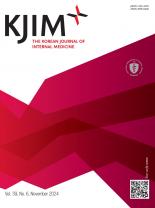|
Gastroenterology
Impact of hepatitis B virus infection on the risk of gallbladder polyps: a cohort study
Nam Hee Kim, Hong Joo Kim, Ji Hun Kang
Korean J Intern Med. 2023;38(6):844-853. Published online October 18, 2023
Background/Aims: We aimed to determine whether hepatitis B virus (HBV) or hepatitis C virus (HCV) infection remains an important risk factor for gallbladder polyps (GBPs) in the current context of reduced prevalence of these infections.
Methods: The cohort included 392,913 asymptomatic adults who unde..
|
|
|
Role of tenofovir disoproxil fumarate in prevention of perinatal transmission of hepatitis B virus from mother to child: a systematic review and meta-analysis
Young-Sun Lee, Ha Seok Lee, Ji Hoon Kim, Sung Won Chang, Myung Han Hyun, Haein Bak, Sehwa Kim, Min-jin Lee, Chan Uk Lee, Young Kul Jung, Yeon Seok Seo, Hyung Joon Yim, Jong Eun Yeon, Soon Ho Um, Kwan Soo Byun
Korean J Intern Med. 2021;36(1):76-85. Published online December 31, 2019
Background/Aims: To prevent the perinatal transmission of hepatitis B virus (HBV) from mother to child, administration of an antiviral agent during pregnancy has been attempted in women who are either hepatitis B e antigen positive or have a high viral load. In this systematic review and meta-analys..
|
|
|
Prognostic impact of hepatitis B or C on intrahepatic cholangiocarcinoma
Jung Woong Seo, Byung Soo Kwan, Young Koog Cheon, Tae Yoon Lee, Chan Sup Shim, So Young Kwon, Won Hyeok Choe, Byung Chul Yoo, Jeong Min Yoon, Jung Hoon Lee
Korean J Intern Med. 2020;35(3):566-573. Published online January 10, 2020
Background/Aims: Intrahepatic cholangiocarcinoma (ICC) is the second-most common primary liver malignancy, arising from the peripheral intrahepatic bile duct epithelium. Hepatitis B virus (HBV) or hepatitis C virus (HCV) may be involved in the development of ICC. We explored the prognostic value of ..
|
|
|
Long-term real-world entecavir therapy in treatment-naïve hepatitis B patients: base-line
hepatitis B virus DNA and hepatitis B surface antigen levels predict virologic response
Ju-Yeon Cho, Won Sohn, Dong-Hyun Sinn, Geum-Youn Gwak, Yong-Han Paik, Moon Seok Choi, Kwang Cheol Koh, Seung Woon Paik, Byung Chul Yoo, Joon Hyeok Lee
Korean J Intern Med. 2017;32(4):636-646. Published online November 4, 2016
Background/Aims: Entecavir is a potent nucleoside analogue with high efficacy and barrier for resistance. We aimed to investigate the long-term efficacy and viral resistance rate of entecavir and explore the factors associated with virologic response, including quantitative hepatitis B surface anti..
|
|
|
Dermatomyositis associated with hepatitis B virus-related hepatocellular carcinoma
Suh Yoon Yang, Bong Ki Cha, Gihyeon Kim, Hyun Woong Lee, Jae Gyu Kim, Sae Kyung Chang, Hyung Joon Kim
Korean J Intern Med. 2014;29(2):231-235. Published online February 27, 2014
Dermatomyositis is an idiopathic inflammatory myopathy with typical cutaneous manifestations. It has been proposed that dermatomyositis may be caused by autoimmune responses to viral infections. Previous studies have shown an association between dermatomyositis and malignant tumors such as ovarian c..
|
|
|
Gastroenterology
Recent trends in hepatitis B virus infection in the general Korean population
Hyuck Kim, A Ri Shin, Hoe Hoon Chung, Min Kyoung Kim, Ji Sung Lee, Jae-Jun Shim, Byung-Ho Kim
Korean J Intern Med. 2013;28(4):413-419. Published online July 1, 2013
Background/AimsHepatitis B virus (HBV) is the major cause of chronic liver disease in Korea, but viral prevalence has decreased because of hepatitis B vaccination programs. In this study, we investigated longitudinal changes in HBV in fection in the general Korean population.<..
|
|
|
Molecular Epidemiology of Hepatitis B Virus
Jia-Horng Kao
Korean J Intern Med. 2011;26(3):255-261. Published online September 13, 2011
Although safe and effective vaccines for hepatitis B virus (HBV) have been available for nearly three decades, this virus kills at least 600,000 people annually worldwide and remains the leading global cause of chronic hepatitis, cirrhosis, and hepatocellular carcinoma. Because the HBV reverse tr..
|
|
|
Clinical Outcomes of Delayed Clearance of Serum HBsAg in Patients with Chronic HBV Infection
Soon Woo Nam, Jeong Jo Jung, Si Hyun Bae, Jong Young Choi, Seung Kew Yoon, Se Hyun Cho, Joon Yeol Han, Nam Ik Han, Jin Mo Yang, Young Suk Lee
Korean J Intern Med. 2007;22(2):73-76. Published online June 30, 2007
BackgroundSpontaneous delayed clearance of hepatitis B surface antigen (HBsAg) in patients with chronic HBV infection is a rare event. The aim of this study was to investigate the incidence of delayed clearance of serum HBsAg in chronic HBV infection and to determine the chara..
|
|
|
The Inverse Association Between the Presence of Antibody to Hepatitis B Surface Antigen and Atopy in Young Adults
Youngil I. Koh, Inseon S. Choi, Chang-Hwan Park, Jae-Sook Ahn, Seung-Gyu Ji
Korean J Intern Med. 2005;20(3):210-216. Published online September 30, 2005
BackgroundSome bacterial and viral infections may reduce the risk of atopy, and this is based on the concept of their ability to divert the immune system towards the Th1 responses. Most of the hepatitis B virus (HBV) infections occur in the developing countries and this is whe..
|
|
|
















